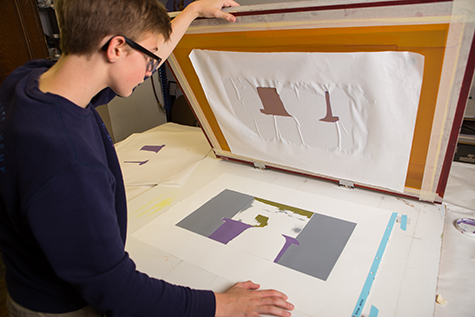The Crucial Overview to Understanding Screen Printing and Its Versatile Utilizes
Screen printing has a rich background that goes back to old times, developing into an advanced method utilized across numerous markets today. This guide discovers the complexities of the screen printing procedure, detailing its applications in home, style, and advertising style - 10:9 Design Abilene. Recognizing these fundamentals can open up creative potential for both business and creative jobs. The adhering to areas will reveal crucial tips and techniques to boost one's screen printing endeavors
The Background of Screen Printing
Screen printing has roots that map back centuries, its advancement reflects the technical and imaginative developments of numerous societies. Originating in old China, the method was initially utilized for enhancing textiles and later infect Japan, where it came to be indispensable to Ukiyo-e woodblock printing. The method changed to Europe in the 18th century, where it gained popularity amongst craftsmens and commercial printers. The development of image emulsion in the 20th century revolutionized screen printing, permitting more detailed layouts and better performance. Musicians like Andy Warhol even more drove its appeal, making use of the medium to produce legendary jobs that combined commercialism and art. By the late 20th century, screen printing had developed itself as a versatile strategy, employed in fashion, advertising and marketing, and fine art. Today, it proceeds to progress, integrating electronic technology and expanding its applications across various industries.
The Screen Printing Process Explained
Screen printing changes imaginative visions into tangible styles with a series of precise actions. A photo is created and then moved onto a screen, typically made of great mesh textile extended over a frame. A light-sensitive emulsion is put on the screen, which is subjected to light, hardening in locations not covered by the photo. After washing out the unhardened solution, a pattern is formed.
Next off, the screen is placed over the substratum, whether it be fabric, paper, or another material. Ink is then pushed via the open locations of the stencil making use of a squeegee, transferring the design onto the substrate listed below. This process can be repeated for numerous shades, requiring separate screens for each and every shade. The printed product is healed utilizing warm to assure the ink adheres correctly, resulting in a resilient, lively layout prepared for usage.
Sorts Of Screen Printing Techniques

Additionally, specialized techniques, such as discharge screen printing, remove color from the fabric to produce softer prints, while aluminum foil screen printing uses metal foil to attain a glossy coating (10:9 Design Texas). Each strategy provides distinct features, accommodating different creative requirements and manufacturing ranges, eventually broadening the opportunities within the screen printing domain
Applications of Screen Printing in Various Industries

Additionally, the signs and advertising industries use screen printing for producing captivating display screens and banners. This technique enables vibrant colors and detailed styles that catch focus. In electronics, screen printing is used for applying conductive inks to circuit card, necessary for part connections. Additionally, the home decoration market embraces screen printing to produce unique layouts on textiles and wall surface art. In general, screen printing works as an important device throughout varied fields, boosting products with customized and visually appealing graphics.
Tips for Successful Screen Printing Projects
While taking on a screen printing task, cautious focus to detail can substantially improve the last result. First, selecting high-quality materials is essential; this consists of the screen, inks, and substrates. Utilizing suitable mesh counts can browse around this site impact ink deposition and detail resolution. Prep work is equally crucial; extensive cleaning of displays and appropriate exposure times ensure crisp prints.
Next, precise registration is important for multi-color prints. Utilizing alignment devices can assist attain specific layering. Additionally, testing prints on scrap materials prior to manufacturing aids recognize prospective concerns without wasting sources.

Regularly Asked Concerns
What Materials Are Finest for Screen Printing on Fabric?
Cotton and polyester blends are excellent for screen printing on material because of their durability and ink absorption. Additionally, specialty fabrics like silk or canvas can create distinct structures and surfaces, enhancing the overall layout top quality.
Exactly how Do I Tidy and Maintain Screen Printing Tools?
To keep and cleanse screen printing devices, one must consistently clean displays with appropriate solvents, inspect mops for wear, lubricate relocating components, and shop all items in a completely dry, dust-free setting to lengthen their lifespan.
What Are the Environmental Impacts of Screen Printing?
Screen printing can have considerable ecological effects, including chemical waste from solvents and inks, water use during cleaning procedures, and power consumption. Lasting techniques and green products are important for reducing these unfavorable results.
Can Screen Printing Be Done in your home Properly?
Screen printing can be successfully done at home with the appropriate materials and techniques. Enthusiasts can create quality prints, though success relies on their skill degree, equipment, and understanding of the procedure included.
What Are the Expenses Related To Starting a Screen Printing Company?

Beginning a screen printing company entails costs for equipment, materials, and workspace. First expenses usually vary from a few hundred to numerous thousand bucks, depending upon the range, top quality of equipment, and wanted manufacturing capability.
Screen printing has an abundant background that dates back to old times, advancing right into a sophisticated technique used throughout various markets today. Another technique, rotating screen printing, uses cylindrical screens, promoting constant printing on material rolls, consequently improving effectiveness for large manufacturings. In addition, specialty methods, such as discharge screen printing, get rid of color from the textile to develop Get More Info softer prints, while aluminum foil screen printing uses metallic aluminum foil to accomplish a glossy coating. In the style industry, screen printing is commonly used to create vibrant styles on apparel, making it possible for brand names to display their special styles. Cotton and polyester blends are perfect for screen printing on material due to their longevity and ink absorption.